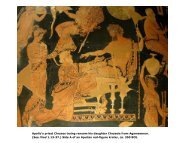Maya Flasks & Carlson Intro Kislak Catalog 2007
Maya Flasks & Carlson Intro Kislak Catalog 2007
Maya Flasks & Carlson Intro Kislak Catalog 2007
Create successful ePaper yourself
Turn your PDF publications into a flip-book with our unique Google optimized e-Paper software.
Rollout of bowl with carved underworld scene and five hieroglyphs, Late Classic <strong>Maya</strong>, a.d. 600–900 (see entry 60).<br />
of the Isthmus, arose Mesoamerica’s most famous early civilization,<br />
the Preclassic Olmec (1200–400 b.c.). The ancient<br />
Olmecs came to influence all of Mesoamerica, but they were<br />
themselves influenced by previous individual chiefdoms and<br />
incipient states developing in the Mexican Highlands as well<br />
as the Coastal Lowlands.<br />
Three great strengths of the Greater Mesoamerican geographical<br />
region led to the development of several of the true<br />
high civilizations of the ancient world. First, a richly diverse<br />
geography—with many extreme ecological niches with their<br />
own microenvironments—fostered long-distance trade for<br />
raw materials and luxury goods, which, in turn, created innovative<br />
cultural exchange networks beginning in the Late<br />
Archaic period. Second, a geological wealth of stone varieties<br />
stimulated the development of new lithic technologies,<br />
such as the invention of limestone-based plasters and exquisitely<br />
knapped obsidian blades; a geological wealth of<br />
minerals provided brilliant pigments, including cinnabar,<br />
vermilion, and the unique man-made “<strong>Maya</strong> blue”; and<br />
rich soils engendered new agricultural technologies such<br />
as chinampa raised-field systems in wetlands and lacustrine<br />
zones, and extensive cacao plantations under sheltered forest<br />
canopies. Third, a rich, diverse universe of plant life that<br />
ultimately yielded the special blessings of the population’s<br />
healthful, balanced diet, beginning with maize, beans,<br />
squash, capsicum chili peppers, cacao (from which chocolate<br />
is made), plus a true shaman’s pharmacopoeia of “entheogenic”—creating<br />
god within us—plants and animals, such<br />
as peyote, Psilocibe mushrooms, Datura, morning glory seeds<br />
(e.g., for the psychoactive ololiuhqui of the Aztecs), tobacco,<br />
mescal beans, and the toxins from the parotid glands of<br />
such toads as the Bufo marinus and Bufo alvarius, to name only<br />
a few. Mesoamericans enjoyed a sophisticated system of<br />
medicine based on these unique natural sources. The miracle<br />
of the human invention of corn, beginning at least seven<br />
millennia ago in the Middle Archaic, would change all of the<br />
Americas, not to mention the rest of the world after Spanish<br />
contact beginning in the late fifteenth century.<br />
Of the five core areas of the ancient world where writing<br />
was independently invented, including Mesopotamia,<br />
Egypt, China, and the Indus Valley, Mesoamerica stands out<br />
for its creation of the full logo-syllabic <strong>Maya</strong> glyphic system<br />
where thought and speech could be recorded in the most visually<br />
diverse and visually poetic scripts ever conceived. The<br />
evidence is now strong that, in fact, two full writing systems<br />
were created: the <strong>Maya</strong>n and the still poorly known Isthmian,<br />
which was most likely derived from a di=erent language base<br />
(hypothetically, Zoquean). Furthermore, the unique culturally<br />
defining Mesoamerican calendar system was among<br />
the world’s most elaborate and accurate, based on many interlocking<br />
cycles presided over by deified time periods and<br />
numbers. Their advanced arithmetic system was based on<br />
the count of 20 (a vigesimal system derived from the human<br />
form), the use of place notation, and included the concept<br />
of zero or “completion,” the first sophisticated mathematics<br />
of its kind anywhere in the world. This enabled the Mesoamerican<br />
peoples to develop an advanced observational<br />
astronomy and numerology that lead to cultural traditions<br />
of calendrical divination and prognostication, some aspects<br />
of which still survive among the <strong>Maya</strong> in the highlands of<br />
Guatemala today. Other systems of pictorial writing and rich<br />
iconographic representation were developed across ancient<br />
Mesoamerica. These include the pictorial hieroglyphs of the<br />
early Zapotecs carved on stone monuments and the later system<br />
recorded in books of the Mixtecs, both in Oaxaca, as<br />
well as the still enigmatic “notational sign” ensemble writing<br />
of Teotihuacán and the far better known Mexica or Aztec<br />
system, both in the Central Mexican Altiplano. These writing<br />
and iconographic forms could be and were recorded on a<br />
wide variety of media, including stone, wood, shell, ceramics,<br />
textiles, animal hides, and the unique screen-fold codex<br />
books painted on stuccoed bark papers—usually of Ficus,<br />
Morus, or Maguey agave fibers—and deer skin. Although most<br />
of the great Mesoamerican libraries are now lost forever due<br />
to the passage of time and decay as well as active destruction<br />
by the European newcomers beginning five centuries<br />
ago, much of this priceless literary cultural heritage survives<br />
on media other than paper and now receives a proper home<br />
in the United States Library of Congress, where it may be<br />
studied by scholars and appreciated by all the citizens of the<br />
world for the ages to come.<br />
—John B. <strong>Carlson</strong><br />
Chapter I: From the Olmec to Columbus / The Indigenous Cultures Before European Contact



